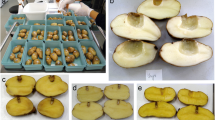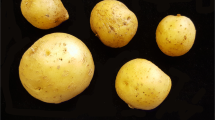Summary
Studies involving single-sporangium and single-zoospore isolates of 10 cultures of different potato physiologic races ofP. infestans suggest that any race will readily change to include the race 4 characteristic in addition to those previously recognized. The character appeared in isolates of race 0 as race 4, in isolates of race 1 as race 1,4, in isolates of race 3 as race 3 4. in an isolate of race 1,2 as race 1,2,4 and in an isolate of race 1,2,3 as race 1,2,3,4. This change was interpreted as being due to mutation of nuclei within the thalli with the mutant nuclei being carried in heterocaryotic mycelium along with the original nuclei. The ability of the fungus to mutate readily to include the race 4 characteristic is offered as an explanation for the high percentages of race 4 noted in race surveys made by different workers in various countries.
Similar content being viewed by others
Literature Cited
Black, W. 1952. A genetic basis for the classification of strains ofPhytoph- thora infestans. Proc. Roy. Soc. Edinburgh, B. 65:36–51.
Doling, D. A. 1956. Distribution of physiological races ofPhytophthora infestans (Mont.) de Bary in Northern Ireland. Nature 177:230.
Graham, K. M. 1955. Distribution of physiological races ofPhytophthora infestans (Mont.) de Bary in Canada. Amer. Potato Jour. 32:277–282.
Hiddema, J. and A. P. Kole. 1954. Enkele waarnemingen over versmelten van zoosporen bijPhytophthora infestans (Mont.) de Bary. Tijdschr. Plantenziekten 60: 138–139. (English summary).
Howatt. J. L. 1957. The late blight disease of potatoes and its causal fungus in Canada. Amer. Potato Jour. 34: 185–192.
Jones, L. R., N. J. Giddings, and B. F. Lutman. 1912. tInvestigations of the potato fungusPhytophthora infestans. Vt. Agr. Exp. Sta. Bull. 168.
Mastenbroek, C. and T. de Bruin. 1955. Het voorkomen van physio 4 vanPhytophthora infestans in Nederland. Tijdschr. Plantenziekten 61:88–92. (English summary).
Pristou, R. and M. E. Gallegly. 1956. Differential reaction of potato hosts to foreign and domestic potato physiologic races ofPhytophthora infestans. Amer. Potato Jour. 33: 287–295.
Takase, N. 1957. An additional report on the difference in phenotypic expressions between genes. R1 and R1, controlling resistance toPhytophthora infestans in potatoes. Euphytica 6: 189–192.
Wilson, J. B. and M. E. Gallegly. 1955. The interrelationships of potato and tomato races ofPhytophthora infestans. Phytopath. 45: 473–476.
Author information
Authors and Affiliations
Additional information
Published with the approval of the Director of the West Virginia Agricultural Experiment Station as Scientific Paper No. 582. This work was supported in part by a contract with The U. S. Army Chemical Corps, Fort Detrick, Frederick, Md.
Rights and permissions
About this article
Cite this article
Gallegly, M.E., Eichenmuller, J.J. The spontaneous appearance of the potato race 4 character in cultures ofphytophthora infestans . American Potato Journal 36, 45–51 (1959). https://doi.org/10.1007/BF02877280
Accepted:
Issue Date:
DOI: https://doi.org/10.1007/BF02877280




